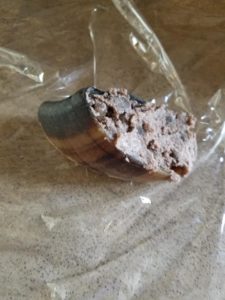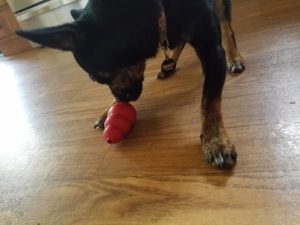Crate training, redirection, and keeping a dog busy in general can be a full time job. Fortunately, some humans have proven to be smarter than our furry companions. We have developed food puzzles. This is the doggy equivalent of humans eating crab legs out of the shell: it takes longer and is therefore more delicious. If you don’t like crab, go away. If you are allergic, I’m sorry you’re missing out.
That said, I often refer clients to food puzzles to alleviate a variety of undesirable behaviors that their dogs have developed. Food puzzles are a fantastic diversion from the anxiety often induced by long periods of boredom or loneliness. Most dogs I have met do not have the constant entertainment of facebook, pinterest, or even being able to turn the channel. Life would be ridiculously boring for me if I had nothing to do all day. Using food puzzles during crate training keeps a dog happily occupied with a productive task. They’re also an excellent tool for a dog who paces, whines, or gulps their food too quickly. Slow eating means your dog can recognize his or her “full” signals better, thereby reducing the risk of over eating. Additionally, a busy dog, a dog with something tasty upon which to chew, is less likely to destroy furniture, walls, and possessions.
Now that I’m done lecturing, I’d bet that if you don’t already know, you’re wondering what on earth a food puzzle is… Good question. A food puzzle is any device, scenario, or toy that can be filled with food or treats which delays a dog’s immediate consumption of the food or treats. The simplest form of a food puzzle is probably a simple food bowl with a ball placed on top of the food. This method is great for dogs who gulp food, but less great for dogs who also gulp tennis balls. Food puzzles can also include the classic Kong, the Kong wobbler, stuffed bones and hooves, puzzle boards, and a hundred other types of home made or store bought puzzles. (Kong brand also makes a line of products from a more dense natural rubber which is designed for very heavy chewers if you’re concerned that your dog will simply destroy these toys.)
The simplest form of a food puzzle is probably a simple food bowl with a ball placed on top of the food. This method is great for dogs who gulp food, but less great for dogs who also gulp tennis balls. Food puzzles can also include the classic Kong, the Kong wobbler, stuffed bones and hooves, puzzle boards, and a hundred other types of home made or store bought puzzles. (Kong brand also makes a line of products from a more dense natural rubber which is designed for very heavy chewers if you’re concerned that your dog will simply destroy these toys.)
My favorite, easy way to feed the dogs is to stuff and freeze a few cow hooves wrapped in plastic wrap or stuffed into a baggie or container. Simply take a hoof out of the freezer and toss it to a dog between training. Hooves can be found for a dollar or two at most pet stores or feed stores, come in different sizes, and are good for a dog’s teeth. 
Kong products also have these benefits, but cost more initially and are slightly harder to stuff. They’re also dishwasher safe on the top rack, hold more food, and last a lot longer than a cow hoof, so there are benefits to each of my favorite feeding strategies. If you’re shopping for Kongs, look for a kong that is large enough to provide entertainment but appropriate for the size of dog you have. Ritchie (chihuahua) has an extra small kong, but would be happy with a small. Jasmine (90 lb american bulldog) has a large, but could probably tolerate an XL. Consider also your dog’s chewing tenacity. Jasmine doesn’t put much effort into anything besides napping and cuddling, honestly, so she is fine with a red Kong, but could probably even use a pastel puppy Kong. This is also why she can eat food from a frozen hoof. Large or aggressive chewers might be better off with an extreme Kong or a large marrow bone stuffed.
If you have an especially bored, destructive, or anxious dog, try a food puzzle. Try LOTS of food puzzles. Build some fun toys to occupy your dog’s time and improve your bond. Training should be fun for you and your pup. A little bit of preparation will go a long way and you’ll find that life is easier for you both.
Here’s a short list of alternative food puzzles, toys, and general enrichment activities to keep your pup out of trouble:
(I haven’t tried all of these, but those I have not yet tried, have been suggested to me by reliable friends and clients.)
Bionic dog toys These toys, made by Outward Hound, are usually stuffable, come highly recommended, and have excellent reviews.
Kong Extreme I have never had a dog destroy these in an unreasonable time period. I’ve heard of it happening, but rarely.
Snuffle Mat I’ve seen tutorials on how to make these. They’re a wonderful food puzzle and enrichment activity. The link I posted is just an affordable, simple mat. There are much different styles. I encourage you to look into the different types and find one that suits your dog.
Food Dispensers I’ve linked the type that I have (two). I use these to feed meals to small dogs (or if filled repeatedly, large dogs), to distract a group of dogs who don’t resource guard food, or to entertain and distract puppies. I would NOT recommend this toy for especially heavy chewers as it could probably be broken into tiny bits…My dogs haven’t.
